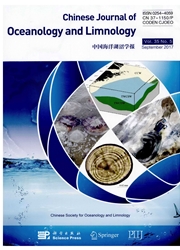

 中文摘要:
中文摘要:
从低价值鱼蛋白质获得的鱼蛋白质 hydrolysate (Fe-FPH ) 螯的 Fe 2+ 的准备被介绍,它的简历活动被化合物在发酵学习。为 hydrolysate chelating Fe 2+ 的最佳条件在 5% 点是 DH (水解作用的度) , pH 7.0,为 FM 的 20 ° C 和 15 min chelating 时间(材料没正在被使脱去脂肪) 。包括 CA (在 chelating 以后的存款) 的 Fe-FPH 的四种类型, CB (在 50% 绝对乙醇答案的存款) , CC (在 80% 绝对乙醇答案的推迟的存款) ,和 CD (在 80% 绝对乙醇答案的底部存款) 是有从 FM 的绝对乙醇的 fractionated。通过红外线的光谱的结构的分析表明那 Fe 2+ 与强烈被相结合氨基组并且在螯的各个和每 Fe 2+ 的 carboxyl 组能形成二五成员的戒指结构。所有四 chelates 被看更多的重要抗氧化的活动并且能被用作自然恐水病、吸水的抗氧化剂。在所有 chelates 之中, CB 拥有最有效的抗氧化的活动在 92% 象 a-tocopherol 的一样高。在所有 Fe-FPHs 之中,仅仅 CD 对 Escherichia 关口 i,葡萄球菌 aureus,沙门氏菌 typhi,和杆菌显示出最有效的抗菌剂活动敏锐是并且能被用作自然抗菌剂。它在食物工业作为添加剂为低价值鱼蛋白质的利用和 Fe-FPH 的关键信息提供一个更有效的方法。
 英文摘要:
英文摘要:
Preparation of Fe^2+ chelate of fish protein hydrolysate (Fe-FPH) obtained from low value fish proteins was introduced and its bioactivity was studied by compound enzymolysis. The optimum conditions for hydrolysate chelating Fe^2+ are DH (degree of hydrolysis) at 5%, pH 7.0, 20℃ and 15 min chelating time for FM (material not being defatted). Four types of Fe-FPH including CA (deposit after chelating), CB (deposit in 50% of absolute ethanol solution), CC (suspended deposit in 80% of absolute ethanol solution), and CD (bottom deposit in 80% of absolute ethanol solution) were fractionated with absolute ethanol from FM. Structural analysis through infra-red spectrum revealed that Fe^2+ was combined strongly with amino-group and carboxyl-group in each chelate and each Fe^2+ could form two five-member ring structures. All of the four chelates were shown more significant antioxidative activity and can be used as natural hydrophobic and hydrophilic antioxidant. Among all the chelates, the CB possesses the most effective antioxidative activity at 92% as high as that of a-tocopherol. Among all Fe-FPHs, only CD showed the most effective antibacterial activity against Escherichia coli, Staphylococcus aureus, Salmonella typhi, and Bacillus subtilis and can be used as natural antibacterial. It provides a more effective way for utilization of low value fish proteins and key information of Fe-FPH as additive in food industry.
 同期刊论文项目
同期刊论文项目
 同项目期刊论文
同项目期刊论文
 Amino acid compositions and anti-anaemia action of hydrolyzed offal protein from Harengula Zunasi Bl
Amino acid compositions and anti-anaemia action of hydrolyzed offal protein from Harengula Zunasi Bl 期刊信息
期刊信息
